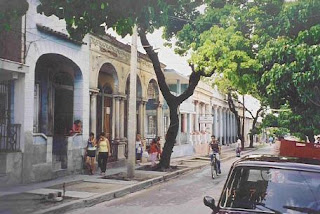
An experience shared by Jetta Bates
Our first night in Cuba was spent at Havana's Hotel Ambos Mundos, an eclectic accommodation built in the late 1920's. The rooms were sparse yet comfortable. The hotel also offered a rooftop brunch. I endured a couple of sideways looks when I first stepped through the door; Cubans are not welcome in hotel lobbies or the rooms (unless they work there), but as soon as I began to speak those frowns turned upside down and a cocktail materialized.
Cuba does not accept US credit cards and has stopped the circulation of American currency, we deposited our funds into TransCard, a global debit card that allows you to withdraw money from the bank or use directly at retailers and hotels for purchases. What we did not take into account was Cuba's poor telephone infrastructure, which temporarily leaves banks unable to connect to other off-island banking institutions to verify funds. We were only scheduled to stay a day in Old Havana, so we packed our pockets with food from the buffet since we were not sure where our next meal would come from. We then began hoofing it with luggage in tow to our next destination.
Upon arrival we explained our situation to our hosts, I felt tears welling up. They fed, watered and gave us a simple, cool room in which to take a well-deserved nap. A couple of days later we had access to our money and we hit Old Havana with gleeful abandon, shopping in the shops by Plaza de la Catedral.
There are two economies, one for tourists (Cuban Convertible Peso, which is almost equal to the US dollar) and one for citizens (Cuban Peso). Necessities are far less expensive for Cuban nationals, but the underground market is thriving as other, higher-value currencies are desired. The hustle is alive and well.
Cubans are curious about visitors, asking if we were Dominican, Canadian or European. Eyes brighten when they discover you're American.
We visited El Guajirito, a restaurant recommended by our hosts. It was a small, family run restaurant specializing in authentic local cuisine. The rest of our time was action-packed; we enjoyed an exotic, high-energy show at Club Tropicana, took a Havana city tour and visited the home of a Cohiba cigar roller. We flew in a beautiful new jet to Cayo Largo, the second largest island in the chain of islands surrounding Cuba. Only a handful of resorts there.
Once back in Havana we rented a car and visited Che Guevara's grave in Santa Clara, swam in the Rio San Juan and had the freshest chicken at Hotel Casa Del Campesino.
It was difficult for us to leave. Each city had a story to tell. There was a real sense of kinship and I felt more welcome and connected to the people there than I have in certain US cities. My hope is that no matter what happens, Cuba keeps her heart.










